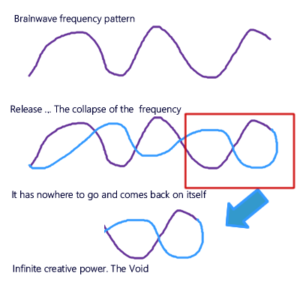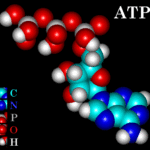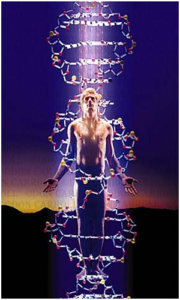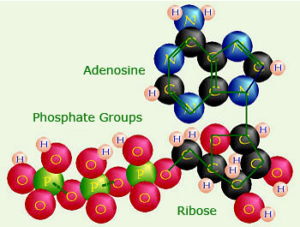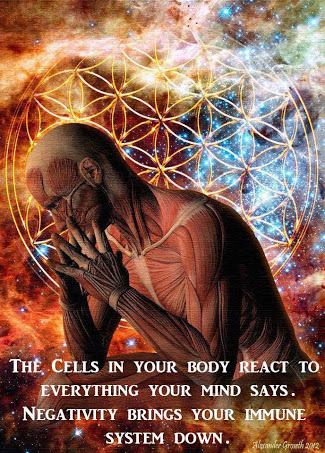What happens when we meditate?
The Dalai Lama has been quoted as saying that the best meditation is sleep. So why is this?
What happens in meditation is we consciously enter the same brainwave frequencies as when we go off to sleep, but the practice accelerates our healing among many other things.
When we enter a different focus of awareness (those who are too linear call them altered states), and expand into that awareness we can heal and manifest easily and effortlessly. When we let go into the void, which really is the collapse of the electrical signals in our brain, we enter an expanded awareness. Infinite healing, creativity and manifestations. Hence, we get the symbol for infinity.
Which brings me to my next subject… The frequency 10Hz which is widely regarded as a frequency (or channel if you like), for health, however, it is not the only frequency for health of course.
All frequencies are imperative to human beings to live as the spectrum between 0.0001 hz and moving up through Delta, Theta, Alpha, Beta and Gamma up to 30-40Hz, and even up to 100 is natural for us.
These frequencies play like a symphony and when some frequencies are too dominant (like Beta for example), or some are missing (like Alpha or Theta or Delta) for example, human form is out of balance and gets tired and sick.
For this reason, meditation restores expansion into these frequencies.
“I cannot teach anybody anything. I can only make them think” ~Socrates
10Hz the Energy Frequency Activates ATP
After weeks of nightly stimulation, cells are so well detoxified and producing such high levels of ATP (known by the body to be associated with youthful levels), that the cells actually revert from mature to developmental DNA signature as proven by NASA*.
*Who also developed neurofeedback (a concentrated form of meditation; the direct application of brainwave frequencies) for astronauts…
All cells need energy to function. Adenosine triphosphate, created using food or sunlight, is the molecule that cells use to store that energy for future use. Adenosine triphosphate, also known as ATP, is the energy molecule of all living cells. When plants get energy from sunlight and animals get energy from food, this energy must be converted to ATP before it can be used by the cells to carry out all necessary functions.
When cells are moderately low in ATP, the major problem may be fatigue or exercise intolerance. [Think of a car engine. If the gas in the tank is good fuel, the engine runs well. If the gas has water or sand in it, the car runs poorly.] Rhabdomyolysis (muscle cell death) occurs when the cells don’t have enough ATP (that is, the car runs out of gas). Constant or on-going weakness may develop as a result of repeated low-grade rhabdomyolysis.
ATP Releases Energy to Power the Cell
Adenosine triphosphate (ATP) is a compound which provides energy for virtually all body’s processes. Its role in health maintenance, especially with regard to heart health, cannot be underestimated. Among other crucial functions, ATP is responsible for the heart’s continual cadence. The human heart contains approximately 700 mg of ATP, enough to fuel one heartbeat per second for ten seconds, and needs a minimum of 6,000 grams of ATP per day to function. As the universal cellular energy currency, ATP is constantly spent and re-made within the body.
How much ATP the body needs, as well as how efficiently it produces ATP, depends on the availability of oxygen and various nutrients in the blood, as well as the heart’s ability to continually circulate blood. Maintaining a healthy cardiovascular system through a heart-healthy lifestyle, inhaling enough oxygen, and obtaining appropriate nutrients through the diet and nutraceutical supplementation are essential means of staying energetic and maintaining wellness.
The key to the energy-generating activity of adenosine triphosphate is the chain of three phosphates at the end of the molecule. In particular, the final phosphate is the most important one.
Outside the cell, ATP can act as a signaling molecule itself. An extracellular release of ATP in different areas of the body can signal pain, oxygen depletion and other biological needs.All of these important functions are the result of the conversion of ATP into ADP, a cellular process that works 24 hours a day to keep organisms functioning and healthy. That’s why adenosine triphosphate is often considered the most important molecule in living cells.
In November 2006 the University of Lubeck sleep study disclosed that slowly oscillating Delta rhythm electric stimulation applied via surface electrodes on the scalp induced an immediate increase in spectral power at the same slow wave (Delta) frequency band, increased endogenous cortical slow oscillations, and increased slow spindle activity in the frontal cortex, resulting in improved slow wave sleep and subsequently better memory consolidation.
Our health is directly related to the integrity of our mitochondria. (2 min video here) Mitochondria, “powerhouse” organelles within all of our cells, are responsible for producing 90 percent of the body’s energy. Highly concentrated in the heart, mitochondria comprise 35 percent of myocyte, or heart, cells. While a skeletal muscle cell will only contain, on average, 200 mitochondria, a typical myocyte contains approximately 5,000 mitochondria.
Low ATP is reportedly involved in many illnesses
There are more than 50 inherited diseases of metabolism that are known to affect mitochondria. Taken together, more than 1 in 4,000 children born in the United States each year will develop a mitochondrial disease by 10 year of age. Four million children are born in the US each year. This means that 1000 to 4000 children will be born each year with mitochondrial disease. By comparison, about 8000 new cases of childhood cancer are reported each year. Both mitochondrial disease and childhood cancer range in mortality from 1O to 50 percent per year, depending on the specific disease. Leigh’s syndrome, for example, is one of the more lethal mitochondrial diseases. It has a mortality of about 50 percent per year after diagnosis.
In 1995, the entire program of the 25th annual meeting of the American Aging Association and the American College of Clinical Gerontologv was devoted to the role of mitochondria in the chronic diseases of aging. Even so, most physicians in America are not yet aware of the connection between chronic diseases and abnormalities in mitochondrial function. Fortunately, this is changing through education. But real change in medicine requires two elements- education and the availability of effective treatment. Progress will be slow until effective treatments for mitochondrial diseases are developed.
How Common is Adult Mitochondrial Disease?
Defects in mitochondrial function have now been I inked to many of the most common diseases of aging. These include Type II Diabetes Mellitus, Parkinson Disease, Atherosclerotic Heart Disease, Stroke, Alzheimer Dementia, and Cancer. Over 50 million people in the US suffer from these chronic degenerative disorders. While it cannot yet be said that mitochondria cause these problems, it is clear that mitochondria are involved because their function is measurably disturbed. Even autoimmune diseases such as Multiple Sclerosis, Systemic Lupus Erythematosus, and Rheumatoid Arthritis appear to have mitochondrial components. Source
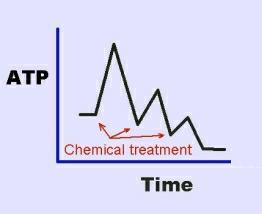
Oxygen infusion and ATP
“Oxygen infusion is often overlooked in regard to its role in ATP synthesis, as the amount of available oxygen is closely related to the body’s ability to maximize ATP synthesis by establishing pathways that produce high-energy phosphate bonds. Because oxygen is essential for maximum ATP synthesis, as well as other positive attributes to the health and visual appearance of the skin, oxygen infusion is a natural partner to be used with microcurrent and light-activated rejuvenation to increase the overall ATP potential and the pursuit of healthy cells and a more youthful appearance.”
- Liver disease
- Heart disease
- So patients with angina, high blood pressure, heart failure, cardiomyopathy, some valve defects as well as patients with cardiac dysrhythmias also have mitochondrial problems and will respond in the same way to nutritional therapies and detox therapies The first effect of poor micro-circulation to the heart is disturbance of the electrical conductivity which causes dysrhythmias. Many patients complain of palpitations, missed heart beats etc
- Hepatitis C
- Metabolic myopathies
- Fibromyalgia
- Weight gain
- Unexplained seizures
- Low blood counts
- Dystonia
- Cancer
- Parkinson’s Disease
- Chronic fatigue syndrome
- Thyroid and Adrenal Malfunction
MORE Symptoms of low ATP
- Fatigue
- Pain
- alpitations
- Depression
- Tinnitus
- General Low body temperature. Coldness. Low Energy or Fatigue.
- Weight problems (can’t lose or gain it). Slow healing.
- Brain Depression. Anxiety. Poor memory, focus, or concentration. Sleep disorders.
Immune system Under-Reactive or Over-Reactive: Frequent infections (skin, sinus, bladder, bowel, yeast problems, etc.). - Allergies. Auto-immune disease.
Musculoskeletal Fatigue. Fibromyalgia (muscle or joint pains). Generalized aches/pains. Repetitive use injury and carpal tunnel syndrome. Weak connective tissues (ligaments, bones, etc). - Headaches.
- Sexual Loss of Libido and function. Menstrual disorders. Infertility.
- Vascular Low blood pressure. High blood pressure. Raynaud’s disease.
- Bowels Constipation. Gas or bloating. Digestive disorders, Irritable Bowel Syndrome (IBS)
Nervous system Numbness of hands and/or feet (usually symmetrical). Dulling or loss of senses such as vision, taste or smell. Skin Dry. Acne. Pallor in light skin, darkening or dark patches in dark skin. - Hair Hair loss, brittle, coarse, dry or oily.
Serotonin is the “happiness hormone.”
“Serotonin is a monoamine neurotransmitter that is produced from an amino acid called tryptophan that is stored within the gastrointestinal track, platelets, and the central nervous system. Ninety percent of it is found in the gut regulating intestinal movements. It is associated with your moods, how well you sleep, depression, anxiety, how you view things, body temperature, energy, muscle contraction, whether your platelets clot or not, and your ability to make decisions.
Brainwave entrainment stimulates the brain using the alpha wave frequency (10 Hz) which allows for an increased release of serotonin”
… and a big P.S. … That’s were meditation takes you!
EMF can heal using PEMF ( Pulsating Electromagnetic Field Therapy)
Chronic fatigue syndrome is the symptom caused by mitochondrial failure. The job of mitochondria is to supply energy in the form of ATP (adenosine triphosphate). This is the universal currency of energy. It can be used for all sorts of biochemical jobs from muscle contraction to hormone production. When mitochondria fail, this results in poor supply of ATP, so cells go slow because they do not have the energy supply to function at a normal speed. This means that all bodily functions go slow.
In 1989 David Hood found chronic (30+ days) 10 Hz stimulation TRIPLED two critical enzymes of final stages of cell respiration, citrate synthase and cytochrome c oxidase.. Testing systemic oxygen consumption via breath-hold-test since 2005 we have found routine improvements in as little as 2-3 days. Cells burn oxygen more efficiently, drawing oxygen from blood slower, producing more energy and less waste from every breath; thus you are able to hold your breath up to 20% longer the first week or two; 2/3rds longer after a year or two and up to 100% longer after several years.
More 10hz Reported uses
10 Hz Treatment for Attention Deficit (Hyperactivity) Disorder (47)
10 Hz Treatment for closed head injury (48)
10 Hz Dominant alpha frequency, clarity, normalcy, anti-convulsant circadian rhythm resync, activate kidneys, raise body temp, more serotonin. (40)
10 Hz Berger rhythm (07)
10 Hz Enhanced release of serotonin and mood elevator, universally beneficial, use to try effects of other mixes (16)
10 Hz Acts as an analgesic, safest frequency, especially for hangover and jet lag. (11)
10 Hz For learning a foreign language fast, (18)
10 Hz In a study using 20 minute sessions of 10-Hz photic stimulation, it was found that the daytime level of melatonin decreased and increases in the levels of endorphin, serotonin and norepinephrine. Shealy’s group suggested that an increase in beta endorphins is associated with a sense of well being and decreased pain. The increase in norepinephrine and serotonin and the decrease in melatonin suggest an increase in the level of alertness. (35)
10 Hz increases in neurochemical levels: 11% increase in Norepinephrine levels, 21% increase in Serotonin levels, 25% increase in Beta-Endorphin levels
NASA Uses Frequencies to Enhance Neural Tissue
Regeneration of nerve cells using 10 hz square EM fields
In 2003 NASA-Goodwin found 10 Hz square wave stimulation caused neural tissue regeneration @ 4x baseline, w/better 3-D orientation; cell DNA signature reverted from maturation to developmental (more than 175 maturation genes and 150 developmental genes pgs. 15-18)..
Cells that are mature are literally “tricked” into believing they are younger than they are. Mitochondrial DNA (mtDNA) may have been repaired through some unidentified mechanism or to adequate detoxification of mitochondrion itself or cell protoplasm within which the mitochondria reside
In NASA study above, mitochondrial robustness due to 10 Hz stimulation provided the energy to support regeneration at 4 times baseline. There is related information in that author’s patents at US 6485963 and 6673597, both of which are titled “Growth stimulation of biological cells and tissue by electromagnetic fields and uses thereof”.
NASA’s CONCLUSION:
“We have clearly demonstrated the bioelectric/biochemical potentiation of nerve stimulation and restoration in humans as a documented reality”.
Final Recommendation: “One may use square wave EM fields for”:
a. repairing traumatized tissues
b. moderating some neuro-degenerative diseases
c. developing tissues for transplantation
*the first study to clarify technologies and efficacy parameters for tissue growth and restoration
Exposure to 10 Hz has an immediate and direct effect on the mitochondria as demonstrated in the studies above. Pure organic ATP according to biological paradigm on planet Earth in both plants and animals.
A 10 Hz pulsed (square-wave) field increases cell’s organic production of ATP (the fuel that fires all cellular processes). This is the premise behind the theoretical proposition we call instantATP (organisms under the influence of pulsed electromagnetic fields 10 Hz).
Regardless of what studies are looked at, most concur with and support the conclusion that healthy cellular function is necessary for a healthy, vibrant body, including the appearance of skin and muscle tone. People understand that, as the human body ages, there exists a natural degradation of cellular function, which is representative of a lack of ATP synthesis ultimately responsible to power the cell. It is also known that specific outside sources, including micro-current, light-activated rejuvenation, and oxygen-infusion technology, can have a substantial impact on the stimulation of ATP synthesis, as well as work in harmony with the natural functions of the body.
There is little doubt that humans are all electrical beings and that ATP is truly the current of life. Having said this, the ability to stimulate ATP synthesis certainly brings people one step further in the pursuit of unraveling the mysteries of the fountain of youth.

